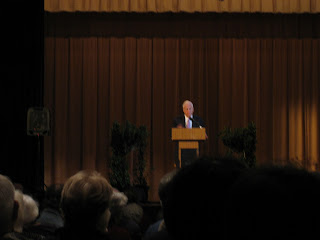Tonight, I went to hear Dr. James H. Billington, the Librarian of Congress, speak. I was pretty excited about his talk since I've been researching a specific exhibition that was censored by Library officials in 1995 and have become quite concerned about some facets of how the Library operates. I therefore have a vested interest in what he'd have to say about the Library's role in contemporary American life and how it is looking toward the future.
Although I did learn some things from Dr. Billington, the big takeaway point from his talk was that he thinks technology is dangerous. Adamant that technology would never offer a compelling substitute for "our book culture," a point on which we do not necessarily have a disagreement, Billington went on to insist that using a computer lead to isolation, that it could be harmful and have negative effects that are not present when one reads books and talks to people about what they've read. Over and over, he insisted that books foster our humanity, but computers do not.

Billington's message really upset me. I love books, but other technologies offer such wonderful possibilities for learning, too. Sure, they also have negative applications, but I think the claim that technology is bad for us and constitutes a regression or de-evolution of society (a point Billington made explicitly) is specious. Technology offers unprecedented ways for people to connect with each other. From school kids using Skype to practice newly acquired language skills with native speakers from other parts of the world to online projects that allow people to fund worthwhile new inventions, there are so many ways that technology enriches our lives and creates new possibilities.
What does any of this have to do with the kitchen, the professed theme of this blog? Excellent question. Billington's insistence that technology makes us disconnected made me immediately want to go home and connect with people, sharing something, potentially with people I've never met and will never meet. My offering is small--it's not exactly the meaning of life or an easy-to-read guide to everything Foucault's ever written, or a treatise on the rights of humankind. It's a darn good chili recipe, though, and it's a framework that you can endlessly modify to make something your own. Further, it's my mother's recipe, and I'm passing it on to you...you know, sharing ideas and connecting with people, kind of how books enable us to share ideas, except, of course, this is no book (although I guess this post is pretty long). We're all part of various communities of practice, and one of the key things I use the internet for is to connect with other people who love to cook, to eat, and to think about where our food comes from and what impact that has on our lives. I'd love to offer Billington, and all of you, a hearty, delicious bowl of chili, 'cause nothing connects us more than the internet except for, well, food.

This is more of a framework than a recipe, so feel free to experiment. Here e ingredients I used last night:
1 14.5oz can pinto beans, undrained
1 14.5oz can great Northern beans, drained
1 14.5oz can dark red kidney beans, drained
1 14.5oz can diced tomatoes
half an onion, chopped small and as uniformly as possible
1 8oz can corn kernels, drained
1/2 pound ground beef
1 McCormick's "50% less sodium" chili packet
a small green bell pepper, chopped small and as uniformly as possible
half a bottle of Blue Moon Harvest Moon Pumpkin Ale
Put all ingredients in a large crock pot, stirring well. Cook on low for 3-3.5 hours, or until veggies are tender. Makes about 5 bowls of chili. Garnish with cheddar cheese, sour cream, and crumbled tortilla chips.
You can, of course, make all sorts of changes. You can eschew the McCormick's and make your own spice blend (but I still use it since it hasn't failed me yet), you can leave the meat out or sub turkey or textured vegetable protein. Change up the bean varieties, the kind of beer, leave the corn out--you get the idea.
So while I won't actually be sending a bowl of chili up to Washington, I think its meaningful to share knowledge with other people in a variety of different ways, even if it means I'm in my pajamas plunking away on my keyboard, and even if "knowledge" in this case is, well, chili.
Labels: chili, Library, recipe









